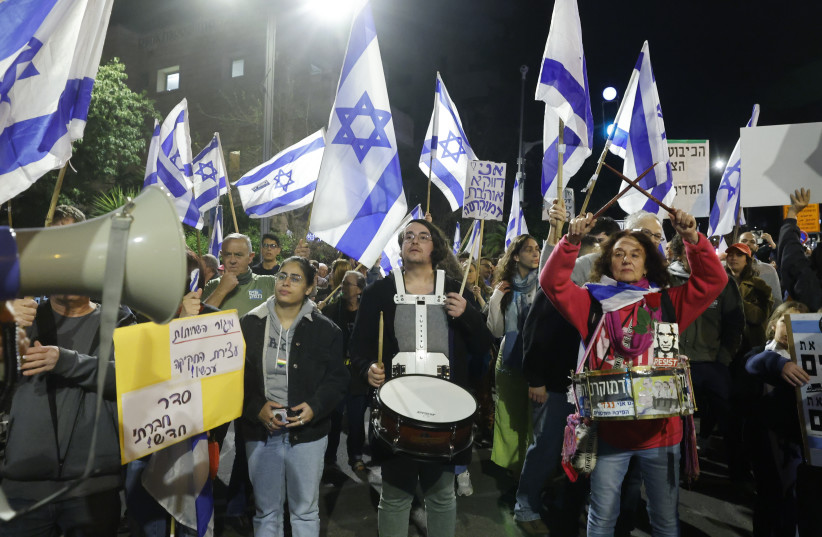Looking back several decades from now, 2023 turned out to be as fateful for the Jewish people as the final compilation of the Torah in 444 BCE, which became the first Constitution of Israel. For it was then that the State of Israel finally adopted its second founding document, produced by a constitutional convention convened by then-president Isaac Herzog. It took nearly a year to establish Israel, for the first time, as a truly democratic Jewish state.
The man-made miracle of Israel’s Constitution was mercifully achieved by the grace of compromise, after years of polarized political enmity and governmental paralysis that brought hundreds of thousands of Israelis of all kinds onto the streets for months. The focus of the protests was then prime-minister Benjamin Netanyahu’s desperate efforts to avoid prison by tinkering with the justice system and threatening the Supreme Court, even at the expense of bringing the country to the point of civil war.
How beautifully ironic it was, when the Supreme Court itself resolved the crisis by granting Netanyahu a plea bargain: he resigned and withdrew for life from all political activity in exchange for all his corruption charges being dropped. His resignation stunned the country into silence. The mass opposition demonstrations that had brought the nation to a halt quickly faded away.
As Israelis settled into life in a true democracy, traffic and ideas began to flow freely once more. The most profound change was that, under the new Constitution, Israel achieved absolute separation between religion and state, modeled after the 250 or so years of the successful American model.
A river of justice began to flow, sweeping the people to new freedoms. The disestablishment of the Chief Rabbinate was probably the most celebrated, allowing civil marriage and recognizing the Conservative, Reform, and Reconstructionist movements as equal recipients of government aid as that received by the various Orthodox persuasions.
Probably the most visible expression of the change to Israeli democracy was at the Western Wall. Under the newly pluralistic policy, the administration of the site was taken from the rabbinate and given over to the Israel Nature and Parks Authority, which then administered it as a national holy site. Equal prayer areas were established for every Jewish denomination, as was public access to the archeological site of the Kotel tunnels.
Among the other immediate beneficiaries of the change was its effect on immigration, by the easing of the Law of Return with respect to conversion. As a religious matter, this issue was left to the control of the various Jewish denominations, which recognized who was Jewish enough to qualify for citizenship. This was followed by a surging wave of aliyah that brought Israel’s Jewish population to exceed that of the United States, becoming the home of most of the Jewish people for the first time.
The new aliyah (Aliyah Vav by now?) made Beersheba bigger than Tel Aviv, as the Negev became settled beyond Ben-Gurion’s wildest dreams. The economy was restored and boosted by an infrastructural transformation that built new roads and railroads across the country, like the new high-speed railroads to Eilat and the Golan.
The Start-up Nation
THE START-UP nation weathered the storm of the crisis, no thanks to the investors who chickened out. They returned in the thousands, taking the economy to record highs that yielded an astounding social return, as long-deferred programs in education and other social areas became fully funded.
The thriving economy narrowed the income gap between the country’s center and periphery, where startups multiplied amid a growing sense of equality of opportunity. High-speed railroads linked cities throughout the country, while light-railways and subways eased travel within cities. The cities themselves grew increasingly green, as the internal combustion engine was replaced by the universal adoption of electric propulsion of all vehicles.
Our relations with our neighbors in the region resumed blossoming, especially following the final resolution of the Palestinian question that had hindered progress for both peoples for more than a century. This was the outcome of what became known as the “Final Intifada,” the month-long war of Palestinian succession following the death of dictator Mahmoud Abbas.
The ensuing first democratic Palestinian election in decades brought a moderate faction to power in Fatah, which won the ensuing internecine battle for control over Hamas with the combined encouragement of the CIA and the Mossad. A demilitarized Gaza became a recognized province of the now terrorism-free Palestinian state.
Israel and the State of Palestine enjoyed their first generation of peaceful coexistence across what was eventually found to be secure and recognized borders. Except for the rare lone, extremist, irredentist jihadist, terrorism was virtually eliminated.
No celebration of the new democracy would be complete without mentioning the long-awaited elimination of Iran’s doomsday threat to exterminate Israel. The decision had not come easily, nor quickly, despite years of warnings over Tehran’s unwavering march to become a nuclear power.
Finally, when the Mossad determined that the mullahs were about to defy international law and carry out the underground detonation of Iran’s first homemade nuclear bomb, Israel was forced to strike preemptively in its – and the world’s – defense. The Israel Air Force’s “Operation Wrath of God” famously destroyed dozens of Iran’s strategic atomic weapons sites, while sparing the reactor at Bushehr.
As happened after the Syria and Baghdad strikes decades before, the world’s reaction was a brief mixture of surprise and relief, followed by boredom, even after the inevitable fall of the mullahs and their replacement by a moderate, secular Iranian government.
Israel’s reaction followed a traditional saying: The dogs bark, the caravan moves on.
The writer is a former chief copy editor and editorial writer of The Jerusalem Post. His debut novel, The Flying Blue Meanies, is available on Amazon.

